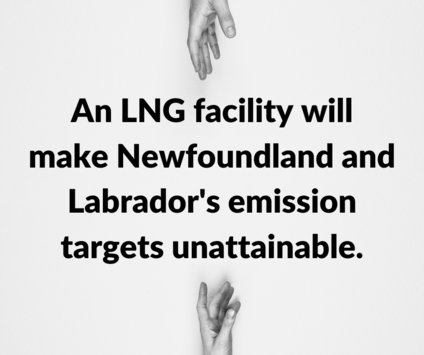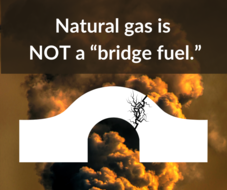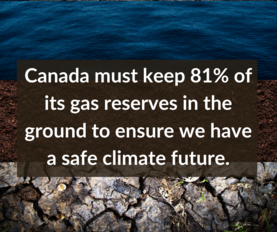
Right now a little-known proposal has been made to build a Liquefied Natural Gas (LNG) Facility and Marine Terminal at Placentia Bay in Newfoundland and Labrador (NL). But scientific evidence on the impacts of natural gas on climate targets supports rejecting this project at this stage.
Such a project would make NL’s provincial climate targets completely unattainable if completed. The arguments for the project - that it would offset the use of coal power elsewhere - are inaccurate and based on the myth of natural gas being a “bridge fuel” for getting off fossil fuels..
As a new fossil fuel project that will contribute to increasing, not decreasing GHG emissions, we call for the project to be rejected right now.
At the very least, given the many short-comings of the project registration document with Newfoundland and Labrador’s Environmental Assessment Division (1) and the immense and unassessed impacts of the proposed under-taking, a new Environmental Impact Statement should be required.
The Sierra Club Canada Foundation submitted the following list of reasons outlining why this project is contrary to our climate targets, and to the well-being of our planet and the people of NL, to the provincial government last week:

1. Natural gas is not a “bridge fuel”, as claimed by the project proponent
The concept that natural gas is a “ bridge fuel” for the transition away from other fossil fuels has been widely debunked. In fact, according to a recent Climate Analytics Report, “gas is the new coal” because emissions associated with natural gas, largely in the form of methane, are much higher and more dangerous to the climate than previously understood. The Climate Analytics report makes it clear that in order to achieve safe climate targets, use of natural gas should have already peaked, and needs to decline rapidly - not increase - as the oil industry projections provided by the proponent (from Shell and BP) purport to illustrate (2).
According to this 2020 Explainer from Reuters, which reviews scientific advice on natural gas:
“Climate scientists say that rising production of natural gas is emerging as one of the biggest drivers of climate change, and that plans for industry expansion could hobble efforts to stabilize the Earth’s climate.” (3)
Methane emissions, an important component of the greenhouse gases emitted from LNG projects, are 86 times more damaging to climate than carbon dioxide, and reducing these emissions is widely considered extremely important and effective in the fight against climate change.
2. The UN has declared a “code red for humanity”.
We are in a climate emergency. Yet, the registration document relies heavily on the environmental assessment of the Grassy Point (Placentia Bay) project which concluded 15 years ago in 2007 (provincially) and 2008 (federally). The assumptions outlined in the report are outdated and ignore recent scientific and energy assessments regarding the necessity and societal benefits of shifting away from fossil fuel infrastructure and consumption.
Newfoundland and Labrador is not immune to the effects of climate change in the form of flooding, unpreceded storms, unpredictable weather, and disconnection from global supply chains. At the same time, Newfoundland and Labrador has immense potential for energy efficiency and renewables, and can be part of climate solutions.
3. The proposed project flies in the face of global climate and energy assessments
The 2021 Intergovernmental Panel on Climate Change (IPCC) Report (5) and the United Nations Environment Programme Emissions Gap Report 2021 (6) both indicate that the severity of climate impacts necessitates an immediate halt to new fossil fuel development if we are to secure a safe climate and achieve GHG emission reduction targets.
Recent analysis published in the journal Nature shows that Canada must keep 81% of its gas reserves in the ground to ensure we have a safe climate future (7).
In rejecting the Énergie Saguenay LNG project after a full impact assessment, Quebec’s Minister of Environment and Climate Change concurred with the assessment report for the project, which stated LNG could, in fact " have the long-term consequence of slowing down the energy transition of the project client countries." [emphasis added] (8)

4. The climate and energy markets do not need natural gas
The International Energy Agency’s (IEA) World Energy Outlook 2021 (9) makes it clear that world energy can be supplied by renewable energy sources, and indicates that forward thinking governments, particularly in regions heavily reliant on fossil fuels such as Newdoundland and Labrador, will need to pave the way for affected workers and communities to support the shift away from fossil fuels.
In contrast to the oil industry projections provided by the proponent, the IEA Outlook report includes much more conservative scenarios for natural gas demand up to 2030: one of these scenarios predicts a sharp decrease in demand after 2025, and the remaining two show moderate increases of 5 - 15% in global demand by 2030.
As stated above, climate science supports rapid scaling away from fossil fuels, including natural gas, in order to protect a safe climate.
5. The project will make provincial emission targets unattainable.
Amongst many omissions, the project registration gives no estimates of GHG emissions or different GHG emission calculations for various possible scenarios, and no credible GHG emission reduction plans. The scant mention of reducing emissions (in the form a few words regarding carbon sequestration, electricity supply from Muskrat Falls mega-hydro) are neither credible, ground-truthed, nor backed up by peer-reviewed science for their efficacy.
Based on comparable LNG projects, such as the Goldboro LNG project (10), we may roughly estimate the project operations are likely to produce on the order of 1 million tonnes of GHG emissions. This does not include full life cycle emissions, which would also include emissions associated with burning the natural gas to generate energy.
Newfoundland and Labrador is currently emitting 11 MT of greenhouse gases, a full 3.4 MT or approximately 50% above its target of emitting 7.4 MT of CO2equiv by 2030, a short eight years or two government mandates away (11). This project will make such a target unattainable. The proponent makes no mention of provincial emission targets, and fails to indicate how this project would affect provincial GHG emission targets or contextualize these impacts within projected cumulative impacts of the rapid acceleration of oil drilling being promoted by the province.
6. Project contravenes commitments to phase out fossil fuel subsidies
The proposed project will likely require government subsidies to make it viable.
Such subsidies contravene Canada’s long-time commitment as a member of the G20 to phase out fossil fuel subsidies, and the current federal government's commitment to phase out fossil fuels subsidies by 2023.
7. This project defers necessary up-skillling and investment opportunities in jobs of the future
Not only will this project make provincial GHG emission targets unattainable and subvert commitments to end fossil fuel subsidies, it will divert taxpayer dollars and government resources away from supporting sustainable jobs of the future.
As stated above, the project is unlikely to proceed without government subsidies. However, the Canadian government has committed to phase out fossil fuel subsidies by 2023. In addition, public dollars should be allocated to decrease, not increase, impacts of climate change and support communities affected by this necessary transition. As stated in the previously cited IEA World Energy Outlook 2021:
“new jobs are not necessarily created in the same places where jobs are lost. Skill sets are not automatically transferable, and new skills are needed. This is true both within specific countries and internationally. Governments need to manage the impacts in a coordinated way, seeking transition pathways that maximise opportunities for decent, high quality work and for workers to make use of existing skills, and mobilising long-term support for workers and communities where jobs are lost.”
Approval of this project would likely defer these opportunities and resources needed for workers to transition to the renewable energy, low-carbon transportation, and energy efficiency sectors.
8. Learn from the recommendations of the Muskrat Falls Inquiry
As stated above, it is expected that this project will likely be seeking government subsidies to get underway. Many of the recommendations and findings of the Muskrat Falls Inquiry (12) need to be applied to this project, including those regarding transparency and requiring greater and better information than currently supplied in this registration document before sanctioning projects.
In terms of large scope, multi-billion dollar budget, high environmental risk, and reliance on unidentified and changeable energy markets, this project bears some of the hallmarks of Muskrat Falls boondoggle. The words of Commissions LeBlanc could be applied to this registration document:
“The assumptions on which the Project’s economics were based and promoted were not sufficiently tested, and a comprehensive examination of the range of possible outcomes was not undertaken.” (13)
Approving this project without asking more questions about the actual need for the project and requiring further scrutiny would be to repeat the mistakes of Muskrat Falls and place the environment at risk.
The most relevant recommendations of the Inquiry to this process and project are as follows:
“2. The Public Utilities Board should review the proposed business case, reliability, cost and schedule of any large project that could potentially impact Newfoundland and Labrador electricity ratepayers. Following this review, the Public Utilities Board should report its findings to the government and the public.
…
5. The Government of Newfoundland and Labrador should proceed to fund large projects using a probability value of not less than P85. As well, recognizing the likelihood of bias in any cost and schedule estimate, government should require the project proponent to provide a range of cost estimates in order to establish the project’s budget, so that government can determine its own risk appetite. Amounts for tactical and strategic risks should be included in the overall budget but should not be specifically identified or quantified when disclosure is made to the public. Government should authorize the release of dollar amounts for tactical and strategic risks only on pre-determined, structured and well-defined terms.” (14)
Particularly because the project will likely seek public subsidies, the costs and probabilities of successful implementation of different scenarios needs to be outlined and scrutinized to determine their probability of being successfully implemented, as recommended in the Muskrat Falls Inquiry. If the project is to be linked to the electricity grid, this risk could also affect ratepayers down the road, and should be subject to review by the PUB, as recommended by the Inquiry.
We contend that enough is known about GHG emissions from LNG to reject the project right now; however, if the project is not rejected at this stage, it must receive higher environmental impact assessment and review to determine probability of successful implementation, identify required mitigation measures, and timelines. Without greater scrutiny and detail there is simply no way to assess the probability that the project will proceed as the proponent contends or to understand its impacts.
9. Six-hundred kilometre subsea pipeline is risky for marine environment
The project registration describes a ~600 km pipeline to supply natural gas. We are concerned that the registration document does not sufficiently assess risks associated with this pipeline to oceans, existing drilling projects, biodiversity, and fisheries.
The project registration does not provide up-to-date information on biodiversity in the project area, identify the zone of impact for the pipeline, or even the depth of pipeline will need to be laid to prevent iceberg scouring. Such information is vital to assessing risks associated with the project to ocean life and fisheries. Discussing how this additional infrastructure will interact with existing and future drilling projects is also needed to better evaluate environmental impacts.
Since the federal approval of the Grassy Point LNG Project in 2008, Canada has amended the Fisheries Act to protect and restore fish and fish habitat to consider cumulative effects of projects on fish habitats, and requires the federal Fisheries Minister to consider if projects give priority to restoration of degraded habitats, amongst other changes. Canada has also made commitments to protect 30% of its oceans by 2030. These changes, as well as any changes in assessments and mitigation measures required for Species At Risk in the project area of impact should be provided.
Accidents and spills in Newfoudland’s offshore have been frequent in recent years, and the proposed 600 kilometre pipeline, gas hub, and floating LNG vessel proposed here require careful assessment and review. How these projects will interact cumulatively with existing oil and gas activities in the region must also be evaluated.
In summer of 2021, a gas pipeline rupture in the Gulf of Mexico resulted in a fire that caused the ocean to boil at the surface for five hours, creating a so-called “eye of fire,” before it could be put out (15). A rupture of a gas pipeline could have devastating impacts, result in the uncontrolled release of greenhouse gases, and, since conditions in the North Atlantic are often far more severe than those in the Gulf of Mexico, would likely be much more difficult to get under control.
Given the oil and gas and fishing activity in the offshore and coastal environment where the project is located, the risks of accident or leaks will be increased, and must be assessed cumulatively.
10. GHG emissions reduction measures on the project registration are vague and lack credibility
The project registration refers to a possible parallel pipeline to sequester carbon will be “investigated in future studies” and the “[p]otential use” of 180 MW of electricity from Muskrat Falls, but the document lacks adequate information for the Minister to evaluate either of these options with regard to impacts on the project or the environment.
This is of particular concern as carbon sequestration is a speculative technology at best and electricity from Muskrat Falls is expensive. Both speculative proposals will require additional infrastructure, create new, un-assessed impacts, and add costs to the project.
11. Cumulative impacts are impossible to evaluate based on the project registration documents
Given the lack of information in the document regarding actual project components such as a parallel pipeline for carbon sequestration, type of technology proposed to sequester carbon, emissions associated with carbon sequestration, and other offshore and coastal activities such as shipping, fishing, and oil and gas, it is impossible to determine the cumulative impacts of the proposed project on biodiversity, climate change, and adjacent communities.
12. New climate legislation and government initiatives are not mentioned and analysed
SInce the approval of the Grassy Point LNG Project fifteen years ago, Canada has passed the Canadian Net-Zero Emissions Accountability Act that establishes legislated carbon targets of 40-45% below 2005 levels by 2030 and a net zero economy by 2050. The federal government will be producing its emissions reduction plan to achieve its 2030 target and is continuing consultations on a just transition for workers and communities. This fall, Canada joined the Global Methane Pledge, promising to reduce its 2020 methane emissions by 30% by 2030. The provincial government is developing a renewable energy plan and has struck a Net Zero Advisory Council to advise it on how to achieve 2030 and 2050 emission targets. None of these initiatives are discussed in the registration document.
About the Sierra Club Canada Foundation
Sierra Club Canada Foundation empowers people to be leaders in protecting, restoring and enjoying healthy and safe ecosystems. The Sierra Club Canada Foundation (SCCF) is a national registered charity that includes four chapters: Atlantic, Québec, Ontario, and Prairie, plus the Sierra Youth Coalition. In 2020, in response to the dual climate and biodiversity crises, our membership committed to advocating and acting for a Decade of Change with the following objectives: championing climate solutions and a rapid transition to clean energy; fighting for environmental and social justice; working to protect and restore nature and endangered species; getting people outside to explore and enjoy the outdoors; and promoting the conservation of resources.
Sources:
1. https://www.gov.nl.ca/ecc/files/env_assessment_y2021-2177_registration_R...
2. Climate Analytics (2021). Why gas is the new coal. https://climateanalytics.org/publications/2021/why-gas-is-the-new-coal/
3. Explainer: Cleaner but not clean - Why scientists say natural gas won't avert climate disaster. https://www.reuters.com/article/us-usa-gas-climatebox-explainer-idUSKCN2...
4. UN Secretary-General António Guterres, Aug. 9, 2021. https://news.un.org/en/story/2021/08/1097362
5. IPCC, 2021: Climate Change 2021: The Physical Science Basis. Contribution of Working Group I to the Sixth
Assessment Report of the Intergovernmental Panel on Climate Change [Masson-Delmotte, V., P. Zhai, A. Pirani, S.L.
Connors, C. Péan, S. Berger, N. Caud, Y. Chen, L. Goldfarb, M.I. Gomis, M. Huang, K. Leitzell, E. Lonnoy, J.B.R.
Matthews, T.K. Maycock, T. Waterfield, O. Yelekçi, R. Yu, and B. Zhou (eds.)]. Cambridge University Press. In
Press.https://www.ipcc.ch/report/ar6/wg1/
6. United Nations Environment Programme (2021). Emissions Gap Report 2021: The Heat Is On – A World of Climate
Promises Not Yet Delivered. Nairobi. https://www.unep.org/resources/emissions-gap-report-2021
7. Welsby, D., et al. 2021.Unextractable fossil fuels in a 1.5 °C world. Nature. 597: 230–234. (See: Source Data for Figure 1). https://www.nature.com/articles/s41586-021-03821-8
8. Here's Why Quebec Cancelled A Controversial Natural Gas Project. Montreal Blog. July 23, 2021. https://www.mtlblog.com/montreal/why-quebec-cancelled-saguenay-lng
9. IEA (2021), World Energy Outlook 2021, IEA, Paris https://www.iea.org/reports/world-energy-outlook-2021
10. LARRY HUGHES: LNG plant would blow a hole through Nova Scotia’s emissions ceiling. Saltwire Network. Oct. 14, 2020. https://www.saltwire.com/nova-scotia/opinion/larry-hughes-lng-plant-woul...
11. The Canadian Press as reported in CBC News-NL. N.L. will 'need to do more' to meet 2030 emissions targets, briefing notes to Furey shows NL. Dec. 21, 2021. https://www.cbc.ca/news/canada/newfoundland-labrador/furey-cop26-briefin...
12. Commission of Inquiry Respecting the Muskrat Falls Project Muskrat Falls: A Misguided Project: Volume 1: Executive SUmmary, Key Findings and Recommendations. The Honourable Richard D. LeBlanc, Commissioner.Submitted to:
The Honourable Siobhan Coady, Minister of Natural Resources for the Province of Newfoundland and Labrador. March 5, 2020 . https://www.muskratfallsinquiry.ca/files/Volume-1-Executive-Summary-Key-...
13. Ibid.
14. Ibid.
